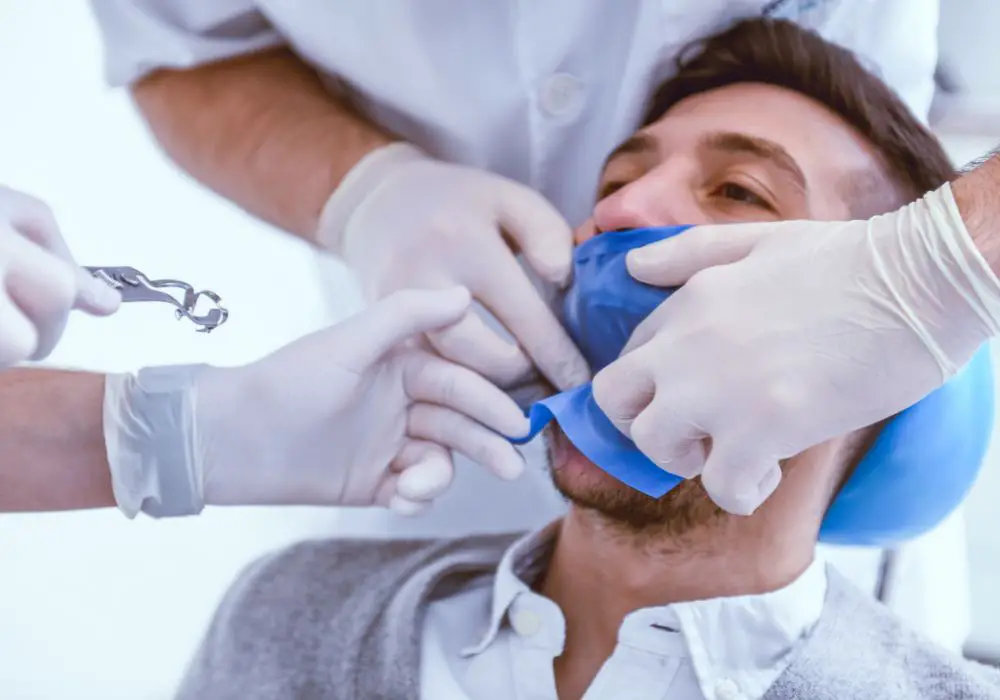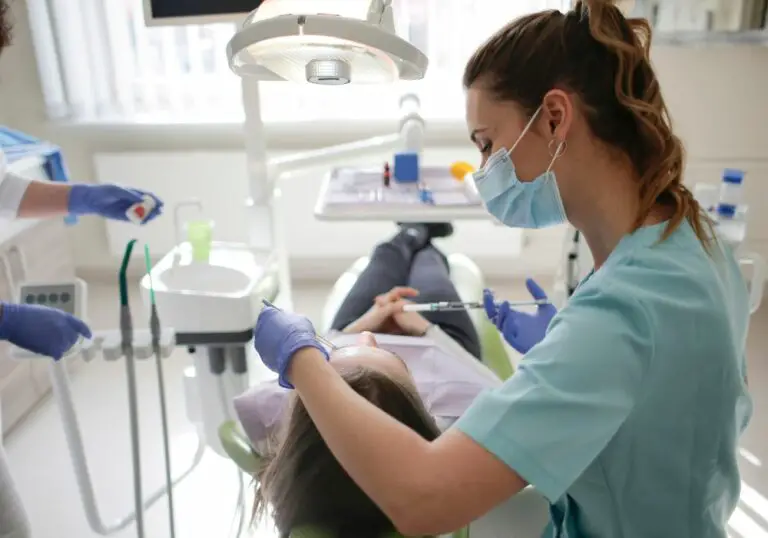Having multiple teeth pulled at once is a common procedure that many patients undergo for various reasons. The number of teeth that can be safely extracted in a single appointment depends on several factors. This comprehensive guide examines the key considerations around multi-tooth extractions to help you understand what to expect.
Key Factors That Determine How Many Teeth Can Be Pulled at Once

There are several important factors that impact how many teeth can be pulled in one appointment:
1. Patient Health
The patient’s overall health is crucial. Those with chronic medical conditions like diabetes, heart disease, or compromised immune systems may only be candidates for removing 1-2 teeth at a time. Relatively healthy patients can typically withstand extracting more teeth in one visit. However, any other health issues like high blood pressure should be evaluated.
2. Type of Anesthesia
The anesthesia used affects how many teeth get pulled. Local anesthesia can numb a few teeth at once. But IV sedation or general anesthesia allow the oral surgeon to extract many more teeth safely since the patient is completely relaxed or asleep. This minimizes any potential pain or discomfort during the procedure.
3. Location of Teeth
Where the teeth are positioned in the mouth impacts numbers removed. Taking teeth next to each other in the same area of the upper and lower jaws is simpler than extracting teeth in totally different quadrants. Removing teeth in different areas requires re-numbing or repositioning the patient multiple times.
4. Condition of Teeth
Heavily decayed, broken down, or fractured teeth require less extraction time and effort than healthy teeth with intact roots. The more difficult the extractions due to fully formed roots, the fewer teeth removed per visit to avoid over-fatiguing the surgeon.
5. Oral Surgeon’s Skill
An experienced oral surgeon with advanced skills, high-tech equipment, and the latest techniques can extract more teeth than general dentists safely in one appointment. Their expertise allows them to perform the procedures faster while minimizing surgical risks.
By carefully evaluating these key factors, the oral surgeon determines the ideal number of teeth to pull for each patient’s unique situation.
Average Number of Teeth Pulled in One Appointment
On average, most oral surgeons recommend extracting 4-8 teeth at once. This range allows them to efficiently perform the oral surgery while also effectively managing postoperative pain and swelling.
However, the average number serves only as a general guideline. Some patients may only require 1-3 teeth removed, like wisdom teeth or badly decayed front teeth. Others may need 10 or more teeth pulled in one visit, such as for full mouth extractions.
The key is the oral surgeon tailoring the treatment plan based on what is optimal and safest for the individual patient after thoroughly assessing their case.
Is it Possible to Pull All Teeth at Once?

Full mouth extractions to remove all teeth in a single appointment is possible but rarely recommended.
This extremely invasive procedure requires removing 16-32 teeth or more depending on if wisdom teeth are present. It carries substantial risks of complications, excessive trauma, and extended recovery times.
Full mouth extractions are only considered for specific situations like:
- Patients with severe gum disease losing all upper and lower teeth or most remaining teeth
- Patients preparing for full mouth implants, dentures, or other tooth replacement solutions, wanting it done as quickly as possible
- Severe tooth decay, infection, or abscesses affecting nearly all teeth
But even in the above cases, most oral surgeons will still stage the extractions over multiple visits for safety. Attempting to remove too many teeth in one surgery can cause excessive bleeding and swelling, increasing chances of complications.
Reasons Full Mouth Extractions in One Visit is Not Advised:
- Surgical risks – Removing all teeth in one extensive surgery dramatically increases chances of bleeding, pain, swelling, infection, and nerve damage to tissues.
- Recovery – Healing from such extensive extractions in one area makes it nearly impossible to properly clean the mouth. Staged visits allow some degree of healing between procedures.
- Bone loss – Extracting all teeth immediately causes rapid resorption or loss of the alveolar bone. This can make fitting dentures or implants later more difficult.
- Cost – Full mouth extractions in one appointment are significantly more expensive with less insurance coverage. Staged visits over weeks or months are more budget-friendly.
Unless the patient’s specific circumstances necessitate it, it is almost always best to carefully break up the extraction procedures over multiple appointments for health and financial reasons.
Ideal Number of Teeth to Extract Per Visit

So what is the optimal amount of teeth to have pulled at one time when you require multiple extractions?
4-6 teeth is the ideal range according to most oral surgeons. This strikes the right balance between:
- Allowing the oral surgeon good access, visibility, and efficiency in extracting the teeth.
- Avoiding excessive surgical trauma to any one area of the gums and bone.
- Limiting post-op swelling, pain levels, and other healing complications.
- Controlling overall procedure time and cost for both the patient and oral surgeon.
For example, removing 1-3 impacted wisdom teeth at once would be at the low end of the range. On the higher end, prepping for dentures may need 6-8 total teeth extracted over 2-3 sequential visits spaced several months apart. Or pulling 4-6 badly decayed teeth at the same appointment.
The key takeaway is the oral surgeon will develop an appropriate phased treatment plan and timeline tailored to the patient’s specific condition and needs regarding their teeth extractions.
How Many Teeth Can Be Safely Pulled in One Appointment?

While the typical range is 4-8 teeth extracted, up to 12 teeth may in some cases be pulled safely at one time with proper planning and care.
However, extracting more than 8 teeth in a single visit is still considered an extensive oral surgery case. The oral surgeon must take additional precautions and measures to minimize risks of complications when removing this many teeth at once.
12 teeth per visit should be the maximum number, only to be done with ideal conditions:
- The patient is relatively healthy with any other medical issues well-controlled.
- The teeth planned for removal are fairly straightforward extractions.
- Only local anesthetic is required and appropriate for this scale procedure.
- The teeth are located together in the same general area which makes access and visualization easier for the surgeon.
In many cases, exceeding more than 8-12 teeth per appointment crosses over into full mouth extraction territory which requires multiple visits. This is to avoid common complications like extensive bleeding, pain levels exceeding medication effectiveness, and increased chances of nerve damage.
Staging the extractions also allows necessary healing time between procedures before the next round of teeth are pulled. This is gentler on the body than marathon sessions removing teeth.
Key Considerations for Multi-Tooth Extractions

Carefully planning a successful treatment timeline for removing multiple teeth requires the oral surgeon to take into account:
Procedure Time
Oral surgeons need to limit lengthy surgeries, especially involving IV sedation, to prevent adverse effects of prolonged anesthesia. Generally keeping visits to 90 minutes or less is recommended, even if not all planned teeth get extracted.
Post-Op Recovery
Removing a larger number of teeth in a single session causes much more swelling, pain, and healing time afterwards. Breaking procedures into smaller chunks of 4-6 teeth extracted allows the body to better recover between visits.
Insurance Coverage
Most standard dental insurance policies limit extraction coverage to 2-4 wisdom teeth removed, or 4-6 total teeth pulled per calendar year. Exceeding these thresholds on one surgery could greatly increase the patient’s out-of-pocket portion of costs.
Infection Risk
Every tooth extracted carries a small risk of developing a localized infection. Limiting visits to 4-6 teeth helps keep this risk to reasonable levels.
Bone Loss
Avoiding aggressive multi-tooth extractions done too closely together prevents excessive rapid bone loss from the jaws before the bone has time to regenerate between visits.
Cost
The patient’s cost is substantially higher when extracting an exceptionally large number of teeth in one marathon session under anesthesia due to insurance limitations. Breaking up procedures over a period of months into smaller surgical visits is often much more budget-friendly.
Procedures Where Multiple Teeth Removal May Be Necessary

Some common situations and dental procedures that can involve extracting several teeth in one appointment include:
Wisdom Tooth Removal
Removing 1-4 impacted wisdom teeth at the same visit is routine practice. But wisdom tooth extraction alone should not exceed 4 teeth during one surgery due to proximity of the nerves.
Prepping for Dentures
6-10 teeth may be extracted over the span of 2-3 visits several months apart in preparation for partial denture or full denture placement once healing is complete.
Severe Gum Disease
Patients with advanced periodontitis often require 4-8 hopeless teeth to be pulled over a series of consultations as the disease progresses. Extractions help stabilize areas being ravaged by the infection.
Major Tooth Decay
4-6 badly decayed teeth may be extracted at one appointment if the teeth cannot be saved by fillings, root canals, crowns, or other restorative treatments. This eliminates sources of infection.
Orthodontic Treatment
When braces are planned, 2-4 teeth may be removed to allow enough space for proper teeth alignment and positioning. Common with premolar extractions prior to braces.
Dental Implants
If a patient is missing 4-6 teeth in the same area, this number of extractions can be done during one surgery to place several dental implants at the same visit.
What to Expect During and After Multi-Tooth Extractions

Understanding the general details of what these procedures entail and how recovery typically goes can help you prepare if you require multiple teeth to be removed:
During the Procedure
The oral surgeon will first administer either local anesthetic shots to numb the area, or provide IV sedation to put you into a relaxed sleep-like state if extracting many teeth. They use various dental instruments like forceps and elevators to carefully loosen and extract the teeth. Stitches are often placed where teeth have been removed to allow the gums to heal closed. Expect noise/vibrations of teeth being removed.
After the Surgery
Significant swelling, bruising, pain, and some minor bleeding are normal for the first 3-7 days following extractions of more than 2-3 teeth. Use ice packs on the face and take antibiotics and pain relievers as directed by your surgeon to help manage discomfort. Follow all post-op instructions closely to allow proper healing. The first 1-2 weeks are the roughest.
Diet After Extractions
Stick to a very soft food diet that requires little to no chewing for at least 7-10 days. Only introduce soft solid foods gradually as the swelling in your mouth reduces and you can open your jaw more. Avoid sharp, crunchy foods for a few weeks that could disturb healing sites.
Healing Timeframe
Most of the intense swelling and pain should subside within the first 1-2 weeks after surgery. But the bone still needs around 3-4 months to fully heal and regenerate where the extractions occurred.
Impact on Facial Appearance
Removing back teeth like molars or wisdom teeth has little effect on facial shape or appearance. However, extracting front teeth can initially cause the chin profile and lips to look slightly more collapsed or prominent until dentures or implants are placed to replace them.
With proper planning by your oral surgeon and closely following post-op care instructions, you can safely undergo medically necessary multi-tooth extractions with the best possible results and recovery.
Frequently Asked Questions About Multi-Tooth Extractions
How many teeth is it safe to have pulled at one time?
The typical safe range is 4-6 teeth for most routine extractions done in a single appointment. Up to 8 may be considered based on factors like the patient’s health and condition of the teeth. More than 8-12 teeth at once starts to increase risks of complications and recovery struggles.
Is it possible to get all teeth pulled in one day?
It is possible in some unique situations but not recommended in most cases. Removing all 16-32 natural teeth in one marathon surgery session is extremely traumatic for both the oral surgeon and patient. Breaking it into multiple visits spaced weeks or months apart is far safer and more affordable.
Should wisdom teeth be pulled together or separately?
The standard practice is removing 1-3 wisdom teeth together in one visit is generally safe. However, extracting all 4 at once does increase chances of more severe swelling and neural damage risks due to their proximity to nerves. Staggering them into separate appointments 2-3 months apart may be advisable if all 4 are impacted.
How long should I wait between multiple tooth extractions?
The ideal timeframe is to schedule follow-up extraction appointments 3-4 months apart. This allows for adequate healing of the gums and bone between procedures. However, the exact timing will depend on factors unique to your specific treatment plan.
How much does it cost to pull multiple teeth at once?
Costs vary based on the number of teeth extracted, type of anesthesia provided, and insurance coverage details. But as a rough estimate, removing between 4-6 teeth in one surgery often ranges from $800-$2000 out of pocket. Full mouth extractions can exceed $5000 or more.
Conclusion
The number of teeth that can be safely extracted in one appointment depends on many individualized factors. While 1-4 is common, some patients require as many as 6-8 or up to 12 teeth pulled at one time. However, removing too many teeth carries risks of surgical complications, extended healing, and cost. Careful planning and evaluation by your oral surgeon allows developing a phased extraction schedule tailored to your specific needs. Following their recommendations closely provides the best results when multiple teeth must be removed, whether for wisdom teeth, gum disease, decay or other issues requiring multi-tooth extractions over time.






